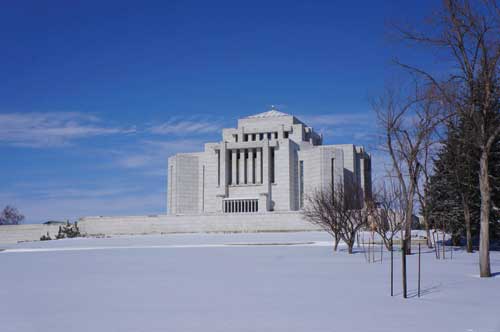It stands today as an iconic symbol and regional landmark, and early last month, a group of citizens gathered at the Cardston library to recognize its significance in shaping the history of this southern Alberta community.
It has been 100 years since ground was broken in Cardston, Alta. for the first Church of Jesus Christ of Latter-day Saints temple built in Canada. Now, with the help of the University of Lethbridge Library, The Cardston Temple: An Historical Record, a digitized collection of photographs and documents about the temple, has been created.
The digital collection represents the work and resources of many individuals and institutions, not the least of which was the U of L library and its specified software and digitization team.
The project began in 2004, when Beth Rosenvall, then Matron of the Cardston Alberta Temple, found a number of photographs under a couch at the temple. Her husband, Lynn Rosenvall, president of the temple from 2003-2006, described the pictures as "temple story photos" and a project was born.

Beth Rosenvall was inspired to tap the community for more photographs, newspaper clippings, obituaries, biographies and other documents related to the temple. Perhaps most importantly, the community supplemented these documents with their knowledge and memories, connecting names to faces, dating photographs and documents, and allowing a story of the temple to emerge.
The narrative is one of a community coming together, facing obstacles brought on by war and a vast Canadian landscape, to construct an iconic building. Its exterior was made of hand-hewn white granite, quarried near the Kootenay Lakes in BC. The construction and furnishing of the building took 10 years and involved the volunteer labour of many.
Since its construction, the building has played an important role in spiritual lives and family histories of many Cardston residents of southern Alberta and beyond.
The relationship between the Cardston Public Library and University Library developed after Rosenvall and her team of volunteers identified and recorded the names of the people in the many photographs that were collected. With painstaking effort, 1,300 pages of pictures and documents were compiled into 11 archival quality volumes by category and with captions. Of the photos gathered, a remarkable 98 per cent of the people pictured were identified.
In an effort to widely share these now developed temple stories, the Cardston Public Library used the Alberta Youth Initiative Program to send Nicole Walton to the U of L Library where she had access to the University's infrastructure and library team to help with the digitization of the collection. Born and raised in Cardston, Walton's expertise and local knowledge proved invaluable as she entered the documents with their metadata, allowing for users to search the collection. She was also able to give insight into how the collection would be used moving forward.
"It is important that younger generations understand the hard work and sweat that went into the construction of the temple," says Cardston Public Library board chairman Vern Quinton.
"It's valuable that we are able to honour the past and prepare for the future," adds library manager Donna Beazer.
A lot has changed over the past 100 years and, certainly, technology is part of our lives in ways that those who toiled over the temple's construction could never imagine. But one thing remains true: it takes the passion and dedication of community members to build something worthwhile.
Explore this fascinating digital collection from the library's website. Go to digitallibrary.uleth.ca/cdm/collist/ and click on Cardston Alberta Temple: An Historical Record.
This story first appeared in the April 2013 edition of the Legend. For a look at the full issue in a flipbook format, follow this link.
